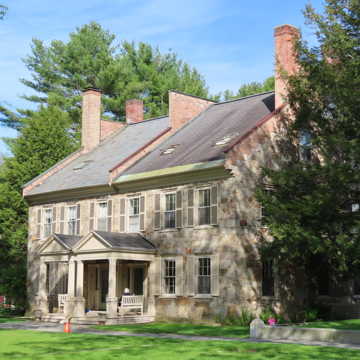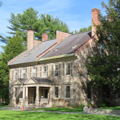As the county shire, Woodstock village developed into the market town for the central Windsor region, with shops lining the streets between the courthouse green and Kedron Brook. Foremost among these was “Edson’s Row,” seven connected two-story brick buildings (demolished). Built by mason Sylvester Edson Sr. and his son Sylvester Jr., these were similar to brick commercial rows in many larger commercial villages, such as Brattleboro and Burlington (also now demolished). In 1827 local Episcopalians had commissioned a stone church, and because of unstable soil conditions at the site, they changed their minds, building the wood-framed St. James Church (WS22) instead. Sylvester Edson Jr. purchased the stone, presumably at a discount, and erected two stone duplexes at the south end of the green around the corner from his brick commercial row. Each half has a three-bay, side-hall plan with a roof parapet between them, and each was owned separately, much like Edson's Row. These two stone duplexes, used variously for business and as dwellings, have survived as the representative work of a family of masons and businessmen who helped shaped the early history of Woodstock village.
You are here
Edson Duplexes
If SAH Archipedia has been useful to you, please consider supporting it.
SAH Archipedia tells the story of the United States through its buildings, landscapes, and cities. This freely available resource empowers the public with authoritative knowledge that deepens their understanding and appreciation of the built environment. But the Society of Architectural Historians, which created SAH Archipedia with University of Virginia Press, needs your support to maintain the high-caliber research, writing, photography, cartography, editing, design, and programming that make SAH Archipedia a trusted online resource available to all who value the history of place, heritage tourism, and learning.














